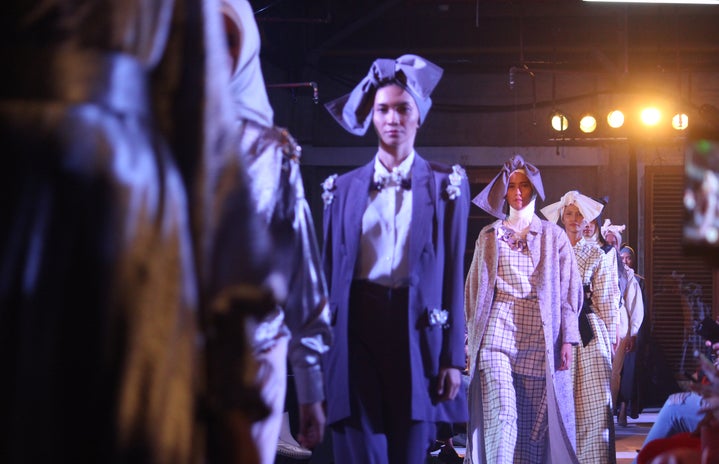At the beginning of this month (if your social media algorithm is at all like mine), your feed was full of influencers and celebrities attending avant-garde runway shows, models getting ready backstage, and glamorous rooftop parties all set against the iconic streets of Lower Manhattan. As alluring as it is, New York Fashion Week (NYFW) is certainly no exception from the criticisms of and debates within the fashion industry, especially regarding environmental and social responsibility. From SheIn haul debates to greenwashing campaigns, to Depop resellers to rental services, consumers have tried to reconcile fashion with sustainability and brands have proven themselves ethical enough to still sell. The increasing awareness of sustainability had some effect on NYFW this year given that there was an uptick of brands improving things like where they source materials, the labor standards of their supply chain, and creating lower-waste show venues. Still, NYFW has yet to put in place regulations for participating brands to have sustainable practices.
However, this August, another fashion week with an explicit focus on sustainability took place in Copenhagen, Denmark. Personally, the only thing fashion-related I previously could name in the whole Scandinavian region is Djerf Avenue by Matilda Djerf (just saying the Djerf Avenue robe is 100% worth the investment). But Copenhagen Fashion Week (CPHFW) introduced me to many more innovative designers who collaborate with the CPHFW organizing board to push fashion boundaries on sustainability and creativity.
Brands showing at CPHFW are required to prove responsible practices for their brand as a whole and their fashion show through both 18 minimum requirements and 58 additional questions in six focus areas. They are: strategic directions, design, smart material choices, working conditions, consumer engagement, and the show itself. Requirements for brands under these categories include proving that 50 percent of the collection is made of sustainable materials, no single-use plastic packaging in their sales or show, fair labor practices, a zero-waste show with an offset carbon footprint, and diverse models and staff.
In some ways, CPHFW’s sustainability efforts are not surprising, given that we often see headlines about how Scandinavian countries are some of those with the smallest environmental footprint. Denmark even ranked first in the 2022 Environmental Development Index (the U.S. is at No. 43) based on its “notable leadership in efforts to promote a clean energy future and sustainable agriculture.” There was also the analysis that the country will reach zero greenhouse gas emissions by 2050.
However, Cecilie Thorsmark, CEO of CPHFW, expressed in an interview with Atmos Magazine that “[h]ere in Denmark, fashion really is the biggest villain … the government won’t touch the fashion industry.” Thorsmark has taken the lead in increasing the sustainability efforts of CPHFW since she became its CEO in 2018. The plan for the 18 minimum requirements was unveiled in 2020 and has been fully implemented this year, the three-year time frame giving brands time to improve their practices.
Some notable brands showing at CPHFW include Ganni, a B Corp company that has recently collaborated with several American brands including Levi’s and New Balance, and (Di)vision, who exclusively uses deadstock and recycled materials to create its workwear-inspired pieces. One of the founders of (Di)vision, Nana Wick, expressed that the perceived limitations of the sustainability requirements at CPHFW were not hindrances to the creativity of their pieces at all, especially as a smaller emerging brand. She is quoted in the same Atmos article as saying, “It’s a big part of our DNA to dive into the limitations of creating fashion … We have this saying, We create from what already is. Within these limitations, we often discover new stuff that we haven’t done before, especially when working with deadstock.”
While NYFW does not have any regulations regarding sustainability for its participants, there is an increasing number of brands innovating with more responsible practices. While not as comprehensive as CPHFW for monitoring the whole supply chain, offsetting carbon emissions, and goals for the company, Business of Fashion reports that 35 out of 71 brands shown at NYFW have some sort of eco-friendly practices and brand identity. Many of these brands at NYFW are working on improving their materials.
One of the best-known examples is Collina Strada, whose materials include previously beach-polluting clothing waste and a silk-like fabric made from rose petals. Collina Strada is quoted saying that being eco-conscious “doesn’t have to be all serious and granola,” and is known for her creativity, which is evident in clothing designs, video-game fashion films, and parody shows of her own brand. Her fashion show at NYFW was itself a commentary on climate change, with models walking with a forced smile, then relaxing at the end of the runway to comment on the paralysis people can feel from the climate crisis. Other notable designers and brands include Grace Ling, who uses 3D printing and CGI to minimize waste in the design process, and Studio 189, who collaborates with artisans in Ghana to create pieces with traditional craftsmanship techniques and support their communities.
There is still debate over whether fashion weeks can be sustainable at all. Critics cite factors like the number of people who need to fly to the event, the cycles of consumerism they perpetuate, and the gray area of auditing sustainability efforts. I think that since people will always love fashion, both individual brands’ efforts and top-down policies play a role in creating a better fashion industry. Also, just throwing it out there, if anyone wants to buy me a Ganni butterfly bag, I wouldn’t complain.
Want to see more HCFSU? Be sure to like us on Facebook and follow us on Instagram, Twitter, TikTok, and Pinterest!


